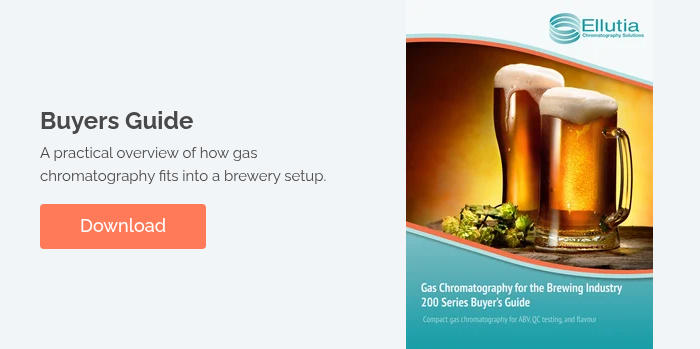VDK (Diacetyl) Analysis in Alcohol
Application Note:
GC-HS Analysis of VDK's in Beer, Wine & Spirits
Introduction
Vicinal diketones (VDKs) are compounds naturally produced during fermentation. They play a major role in how alcoholic drinks taste and smell. In small amounts, they can add smoothness or complexity. In excess, they create unwanted buttery or butterscotch notes that can overpower the intended flavour.
Measuring VDK levels accurately helps producers control flavour and make informed decisions about fermentation timing, conditioning, and product release.

The Challenge
Balancing flavour compounds during fermentation
VDKs such as diacetyl (2,3-butanedione) and acetyl propionyl (2,3-pentanedione) appear naturally as yeast ferments sugars. As fermentation finishes, yeast usually reabsorbs these compounds and breaks them down into less flavour-active forms.
If fermentation or conditioning ends too soon, or the yeast becomes stressed, VDKs can remain at high levels. That leads to buttery flavours that are undesirable in lighter beers, lagers, and ciders but may be acceptable or even welcome in some wines and spirits.
Because these compounds are typically present at parts-per-billion (ppb) levels, accurate measurement requires an analytical method that can detect trace concentrations while avoiding interference from other compounds in the sample.

The Solution
Measuring VDK's with gas chromatography
Gas chromatography (GC) provides the precision needed to measure VDKs at trace levels. The Ellutia 200 Series GC, fitted with an Electron Capture Detector (ECD) and paired with a headspace autosampler such as the Ellutia EL2100H, can detect diacetyl and acetyl propionyl accurately across a wide range of alcoholic beverages.

Headspace GC analysis isolates volatile compounds directly from the sample without liquid injection. This reduces background noise and improves detection limits. It also makes the method faster and more repeatable for routine use in production environments.
With this setup, producers can monitor fermentation progress, confirm product stability, and identify unwanted flavour carry-over before packaging.
If you’d like a practical overview of how gas chromatography fits into a brewery setup, take a look at the 200 GC Buyers Guide for Breweries.
Method Overview
How VDK's are analysed using gas chromatography
Before analysis, samples are degassed by gently passing the liquid between two beakers until foaming stops. This removes dissolved CO₂ and prevents pressure buildup when heating the sample. The degassed sample is transferred into a 20 mL headspace vial, purged with nitrogen to remove oxygen, and sealed for analysis.
The vial is then heated and agitated to allow volatile compounds to move into the headspace. A small volume of vapour is injected into the GC for analysis.
Typical GC Conditions
-
Injector temperature: 160 °C
-
Injector mode: Split (6 mL/min split flow)
-
Column: Analysis column (12 psi pressure, isothermal at 135 °C)
-
Detector: Electron Capture Detector (ECD) at 200 °C
-
Detector current: 10 µA
Headspace Conditions
-
Incubation temperature: 60 °C
-
Incubation time: 15 min
-
Agitation speed: 750 rpm
-
Syringe temperature: 80 °C
-
Sample volume: 1 mL
This method provides stable conditions for repeatable results and allows low-ppb detection levels across beer, wine, and spirits.
Watch
How to Prepare Calibration Standards for VDK Analysis
Learn how to create accurate calibration standards for diacetyl and acetyl propionyl testing. This step-by-step guide shows how to prepare and handle standards used to build a reliable calibration curve for GC analysis.
How to Perform VDK Analysis Using Gas Chromatography
Follow the full process for analysing diacetyl and acetyl propionyl using headspace GC with the Ellutia 200 Series. This walkthrough covers every stage, from sample loading to chromatogram results, showing how to achieve precise, repeatable measurements at low ppb levels.
Results and Reliability
What the analysis shows
The method detects both diacetyl and acetyl propionyl with high sensitivity and consistency. Example results show clear separation of these compounds in standard mixes and real samples:
-
Standard VDK mix at 100 ppb
-
Standard VDK mix at 25 ppb
-
Red wine sample
-
British pale ale sample
The results confirm that headspace GC with an ECD detector can detect VDKs at concentrations as low as 25 ppb. The chromatograms are clear, with sharp peaks and stable baselines, making this approach reliable for routine flavour monitoring.
Testing VDK levels throughout fermentation and conditioning helps producers decide when a batch is ready, avoid unwanted buttery flavours, and maintain flavour consistency across production.
Learn More
Get the full method and results
If you’d like to see the full details behind this testing method, you can download the complete application note. It includes chromatograms, calibration data, and the exact conditions used for the analysis. It’s a handy reference if you want to check your own setup or compare results.
Download the full application note.
It only takes a few moments to signup.
Frequently Asked Questions
-
What are VDK's?Vicinal diketones are compounds such as diacetyl and acetyl propionyl produced during fermentation. They influence the buttery flavour often found in some beers, wines, and spirits.
-
Why test for VDK's?Even small concentrations can change a product’s flavour. Measuring them allows producers to control fermentation timing and prevent unwanted flavour carry-over.
-
Can the 200 Series GC system test for other compounds?Yes. The Ellutia 200 Series GC can also be configured for alcohol content testing, flavour profiling, and other volatile compound analyses.
-
How long does a VDK test take?Each run typically takes less than 20 minutes, and results can be reviewed immediately after analysis.



